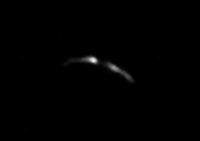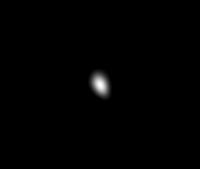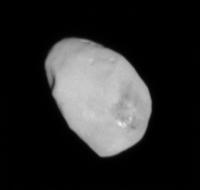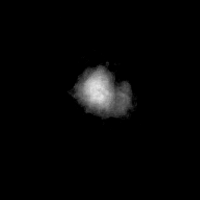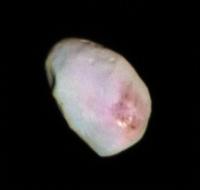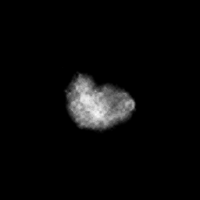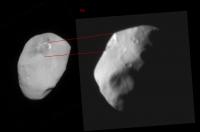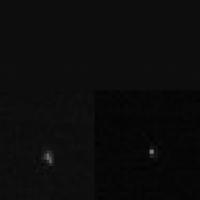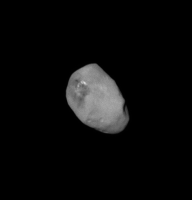Printable Version of Topic
Click here to view this topic in its original format
Unmanned Spaceflight.com _ New Horizons _ Pluto System Small Moons: NH Post-Encounter Phase
Posted by: nprev Aug 1 2015, 06:07 PM
This topic is for discussion of data on Nix, Hydra, Styx, and Kerberos (as well as any other small bodies that may be discovered) received after 1 Aug 2015.
Posted by: Saturns Moon Titan Sep 11 2015, 05:45 PM
First proper image of Nix! It's quite bright.
ADMIN EDIT: Image resized. Please refer to Forum Rules: 3.2 and 3.2. Full image http://pluto.jhuapl.edu/soc/Pluto-Encounter/data/pluto/level2/lor/jpeg/029916/lor_0299167039_0x630_sci_3.jpg.
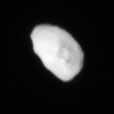
Posted by: Phil Stooke Sep 11 2015, 05:59 PM
Yes - new pix of Nix!
This is a composite of the four frames with a big contrast stretch.
Phil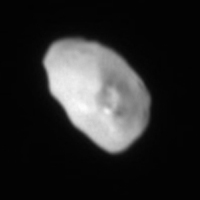
Posted by: machi Sep 11 2015, 06:12 PM
Colorized version using MVIC data:
https://farm1.staticflickr.com/746/21300699956_e1615da5e7_o.png
Posted by: stevesliva Sep 11 2015, 06:51 PM
So, the NH follow-on target, 2014 MU69, is likely no larger than this? But the range here is 200,000km and may be as low as 12,500km there...
Posted by: Superstring Sep 11 2015, 06:58 PM
Reminds me of Prometheus. 
Posted by: Saturns Moon Titan Sep 11 2015, 10:31 PM
Is this the best image we will get of Nix? The Wikipedia page for Nix says the best image will show features down to 330 m/pixel, is this that image?
Posted by: machi Sep 12 2015, 01:39 AM
No it isn't.
There will be better images from the observation "N LEISA LORRI BEST" at resolution ~330 m/pix.
Posted by: Holder of the Two Leashes Sep 18 2015, 09:54 PM
I'm reminded that the much larger Haumea seems to have a red spot on a white surface.
Posted by: Jackbauer Oct 5 2015, 11:32 PM
About Nix and Hydra :
https://blogs.nasa.gov/pluto/2015/10/05/plutos-small-moons-nix-and-hydra/
Posted by: Patteroast Oct 9 2015, 09:03 PM
Styx images have come down today!
Posted by: machi Oct 9 2015, 09:04 PM
Best image of Styx (probably).
I'm not entirely sure if it's really Styx, but manually and even automatically it was identified positively in the 5 of 6 raw jpeg images of Styx.
So this is result of 5 stacked images. Resolution was 3.14 km/pix (before enlarging) and visible disc has dimensions ~20×13 km.
It's enlarged 10×.
Posted by: machi Oct 10 2015, 09:22 AM
Now I know it's really Styx but stacking leads to somewhat bigger size than it's actual size.
My new measurements are (14×8)+/-2 km.
This is still 2× more than is value on the https://www.nasa.gov/nh/new-horizons-picks-up-styx.
I'm not sure where this discrepancy originated.
Posted by: stfletch Oct 19 2015, 01:52 PM
The first images of Kerberos are coming down this week according to https://twitter.com/NewHorizons2015/status/655937436694900736?s=03! I'm intrigued as to why this moon appears to be so much darker than the rest of the Pluto system bodies.
Posted by: alan Oct 22 2015, 06:09 PM
https://www.nasa.gov/feature/last-of-pluto-s-moons-mysterious-kerberos-revealed-by-new-horizons
Posted by: Gladstoner Oct 22 2015, 06:18 PM
Nix:
https://www.nasa.gov/feature/last-of-pluto-s-moons-mysterious-kerberos-revealed-by-new-horizons
Posted by: stevesliva Oct 23 2015, 04:57 PM
I missed the PR text accompanying the Kerberos image until today... It's interesting that they now believe it's less massive than expected, while predictions for the rest were relatively spot-on.
Posted by: stfletch Oct 23 2015, 07:47 PM
Yup. I guess its possible that the interpretation of the gravitational "weighing" could still be correct if Kerberos is a lot denser than the other small moons, though that would be pretty unexpected and hard to explain in itself.
Posted by: ngunn Oct 23 2015, 09:51 PM
It's re-enacting the story of Pluto. Pluto was discovered as a result of a targeted search for a presumed massive body perturbing the outer planets. It was found in the right place but turned out not to have the mass required. In the new as in the old case I imagine the calculations will be rerun to make presumed greater mass of Kerberos unnecessary, poor little thing.
Posted by: nprev Oct 24 2015, 08:21 PM
Looking at the apparent 'dumb-bell' shape of Kerberos it's tempting to speculate that this property combined with varied phase angles between observations may account for the size estimate & albedo errors in some way. Most such estimates assume a more or less spherical body for simplicity's sake.
Posted by: fred_76 Oct 24 2015, 09:28 PM
This is an attempt to colorize Nix using the previous color picture and the last high resolution posted today.
Not that easy because the angles of view are different. I distorded the color picture so that the main structures are surimposed between the images.
Fred
Posted by: Bill Harris Oct 24 2015, 11:11 PM
Don't 'spose it's a contact binary?
Posted by: nprev Oct 24 2015, 11:16 PM
<shrug> Could well be. Doubt we can tell from NH data.
Posted by: Bill Harris Oct 25 2015, 07:18 AM
Given that many small bodies have been observed to be bi-lobed or dumbell-shaped and the several that have been visited and seen to be contact binaries it's not to much a stretch to assume that Kerberos may be.
Posted by: Phil Stooke Nov 6 2015, 03:44 PM
New images of Hydra today. This is a composite of the two images, enlarged 4x.
Phil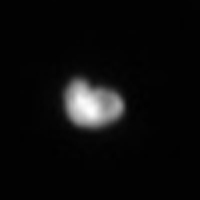
Posted by: alex_k Nov 9 2015, 04:53 AM
My processing of Hydra 07/13 23:16 series, 3 images used, enlarged 6x.
[upd]
...and the series 07/13 04:13, 2 images, 8x.
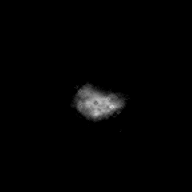
Posted by: alex_k Nov 10 2015, 08:23 AM
A very hypothetic attempt to find match between Hydra series.
From left to right:
07/13 04:13
07/13 23:16
07/14 07:40
Posted by: Bill Harris Nov 10 2015, 10:54 AM
Looks like the NH data suggests that they are contact binaries, or, on another scale, accretionary bodies:
New Horizons data indicates that at least two (and possibly all four) of Pluto's small moons may be the result of mergers between still smaller moons. http://pluto.jhuapl.edu/Multimedia/Science-Photos/image.php?page=1&gallery_id=2&image_id=377
http://pluto.jhuapl.edu/Multimedia/Science-Photos/pics/MergedBodies.jpg
--Bill
Posted by: alan Dec 17 2015, 07:04 PM
https://www.nasa.gov/image-feature/pluto-s-moon-nix-half-illuminated
Posted by: JRehling Dec 20 2015, 05:54 AM
This might make Nix the most densely cratered terrain that we've seen on any world farther out than Saturn? Potentially interesting for establishing cratering rates.
Posted by: TheAnt Dec 20 2015, 09:18 AM
Since more than one satellite of Pluto is thought to be a merger of two bodies, or possibly more. So at some point there might also have been a lot of smaller pieces flying around, in view of that I find the cratering of Nix to be more or less what to expect.
Posted by: vikingmars Dec 29 2015, 09:40 AM
On several of the latest images quoted "Kerberos" there is another body seen below it :
http://pluto.jhuapl.edu/soc/Pluto-Encounter/data/pluto/level2/lor/jpeg/029913/lor_0299136675_0x636_sci_1.jpg (bottom of picture)
http://pluto.jhuapl.edu/soc/Pluto-Encounter/data/pluto/level2/lor/jpeg/029913/lor_0299136614_0x636_sci_1.jpg (middle right)
Another Pluto satellite ? Just a bright star ? ![]()
Posted by: cknight222 Feb 3 2016, 04:26 AM
http://pluto.jhuapl.edu/soc/Pluto-Encounter/data/pluto/level2/lor/jpeg/029913/lor_0299136675_0x636_sci_1.jpg (bottom of picture)
http://pluto.jhuapl.edu/soc/Pluto-Encounter/data/pluto/level2/lor/jpeg/029913/lor_0299136614_0x636_sci_1.jpg (middle right)
Another Pluto satellite ? Just a bright star ?
I blew up the other body in the two images you mentioned and these are what came up.
Posted by: alan May 13 2016, 06:45 PM
Hydra's icy surface
http://www.nasa.gov/feature/pluto-s-icy-moon-hydra
Posted by: Roman Tkachenko Sep 11 2016, 11:41 PM
This animation is based on two images of Nix and generated using morphing technology.
Posted by: nprev Sep 11 2016, 11:59 PM
Fantastic, Roman! ![]()
Posted by: Ian R Sep 12 2016, 02:12 AM
That is very impressive!
Posted by: Decepticon Sep 12 2016, 02:18 AM
WOW!
I wonder what you achieve with a paperclip and gum!
Posted by: Bjorn Jonsson Sep 13 2016, 09:07 PM
This is awesome, especially when one keeps in mind that it is generated from only two images (looking at it without knowing I would have guessed it was generated from a greater number of images).
Posted by: alan Jan 24 2017, 09:33 PM
https://arxiv.org/abs/1701.05594
Powered by Invision Power Board (http://www.invisionboard.com)
© Invision Power Services (http://www.invisionpower.com)
